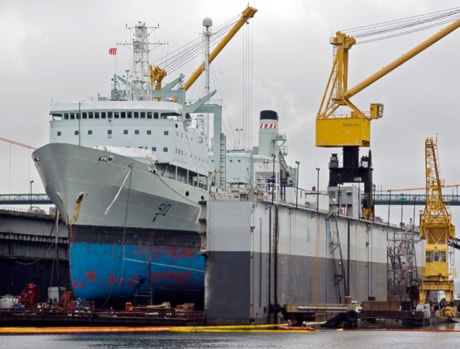OTTAWA, Ont. — Canada’s five big shipyards will slug it out over the next two years to become the preferred builders of a new fleet of combat and civilian ships, federal ministers said Thursday.
Only two yards will construct the estimated 28 big ships the federal government wants to acquire over the next three decades. The remaining companies will then bid on small vessel contracts, as well as repair and refit jobs.
The plan is the centrepiece of the federal government’s shipbuilding strategy, with an estimated $35 billion in navy and coast guard vessel purchases.
To become a preferred “strategic” builder, companies must promise millions of dollars in infrastructure investment as well as job commitments.
“The five shipyards that are going to compete for these two opportunities for long-term contracts with the government of Canada will have to put some skin in the game and show us how they’re going to create jobs and invest in the maritime sector,” Public Works Minister Rona Ambrose said.
“The competitive process begins today.”
Critics warned the strategy could pit both coasts against one another and could also be costly for industry as the notoriously cut-throat companies climb over each other for one of the coveted spots.
“You could have the West Coast and East Coast spending millions of dollars fighting each other over these competitive bids,” said Nova Scotia MP Peter Stoffer, the NDP’s shipbuilding critic.
“There’s enough work to go around and that money from industry can go into building ships instead of beating each other over the head in competition.”
Ambrose said the two shipyards will be chosen “through a fair, transparent, competitive process.”
One of the two preferred builders will focus exclusively on constructing large navy ships. The other will handle civilian vessels, such as the coast guard’s long-promised heavy icebreaker the John Diefenbaker.
Fisheries Minister Gail Shea and Denis Lebel, the minister of state for Quebec economic development, called the strategy a major step forward. Shea is responsible for the coast guard.
The program will produce equipment essential to the Canadian Forces, said Defence Minister Peter MacKay.
“We expect to have signed agreements with these shipyards within two years, which should clear the way toward contracts for large-vessel projects that the navy desperately needs,” he said.
The Liberals dismissed the plan, saying the Conservatives had “dragged out several projects, cancelled most of the others and delayed the re-announcement of plans to build (the navy’s) Joint Support Ships.”
MacKay didn’t say how the strategy will affect several high-profile ship-replacement programs, including the navy’s two supply ships, HMCS Preserver and Protecteur, which turned 40 last year.
The country’s top military commander, Gen. Walter Natynczyk, has said new ships for the navy is his No. 1 equipment need. He noted in a recent speech it has been 14 years since the last major warship was launched in Canada.
Stoffer said it could be years before the supply ships get replaced.
“We’ve heard about the 30-year timeline. I hope the ships don’t get built in the 29th year of this 30year development.”
The federal government first drew up plans to replace the supply ships 16 years ago, but they were shelved during the deficit crisis of the 1990s. The program resurfaced in 2004 under Paul Martin’s government and was promised again by the Conservatives in 2006.
The Tories abruptly shelved the support-ship project in August 2008 when bids from industry came in far over the planned budget.
Ambrose tried to allay fears by saying plans for the supply ships will proceed while Ottawa decides on who will be the builder.
For decades Canada has relied on open competition among yards to build its major warships, and is the last of the NATO countries to move to the model of preferred contractors.
